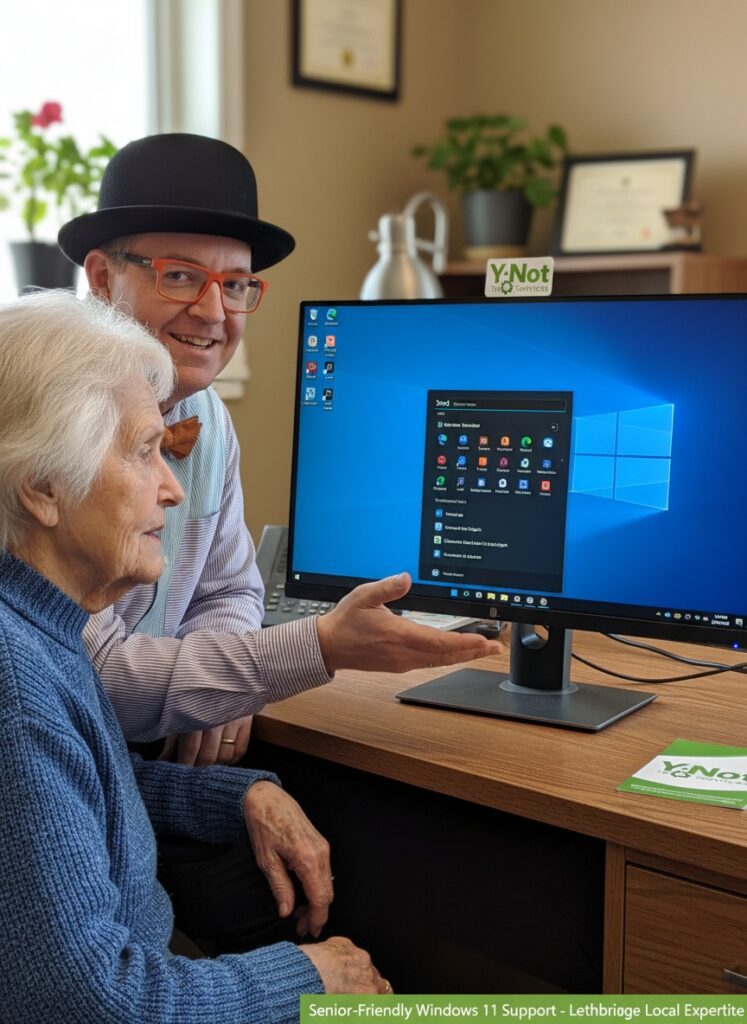
If you’re a senior wondering about Windows 11 for seniors, you’re not alone. Many older adults in Lethbridge and across Canada are asking the same questions: “Do I really need to upgrade?” “Will I lose everything I’m familiar with?” “Is it safe?” As someone who’s helped hundreds of seniors navigate technology changes over the past 15 years, I understand these concerns completely. This comprehensive guide will walk you through everything you need to know about making the transition to Windows 11 safely and confidently.
Why Seniors Need to Know About Windows 11 Right Now
Time is running out for Windows 10 users, and this affects seniors more than any other group. Here’s what you need to know immediately:
Windows 10 support ends October 14, 2025. After this date, Microsoft will no longer provide security updates, bug fixes, or technical support for Windows 10. For seniors who are already prime targets for online scams and cyber attacks, staying on an unsupported system is like leaving your front door unlocked.
In my years helping seniors in Lethbridge with cybersecurity, I’ve seen firsthand how scammers target older adults. They know that many seniors:
- Use older, less secure systems
- May not recognize the latest scam tactics
- Often have substantial savings that make them attractive targets
- May be more trusting of official-looking pop-ups and emails
Without security updates, your Windows 10 computer becomes increasingly vulnerable to:
- Ransomware attacks that can lock you out of precious family photos and documents
- Banking scams that could drain your retirement savings
- Identity theft that can take months or years to resolve
- Fake tech support scams that trick you into paying for unnecessary services
The good news? Windows 11 includes significantly improved security features specifically designed to protect against these modern threats. But the transition needs to happen soon, and it needs to be done right.
Need help understanding your options? Call Y-Not Tech Services at (403) 915-8574 for a free consultation about your Windows 11 transition.
Is Windows 11 Really Different? What Seniors Need to Know
One of the biggest concerns I hear from seniors is: “Will I have to learn everything all over again?” The honest answer is that Windows 11 easy for seniors to adapt to because most of what you already know still applies.
Let me break this down with a practical comparison:
| What You Do Daily | Windows 10 | Windows 11 |
|---|---|---|
| Check Email | Same email program, same process | Identical – no change needed |
| Browse the Internet | Click browser icon, type web address | Exactly the same process |
| Open Documents | Double-click to open | Still double-click to open |
| Video Chat with Family | Teams, Zoom work normally | All programs work the same way |
| Start Menu | Click Windows button, bottom left | Click Windows button, now centered |
What stays exactly the same:
- All your programs (email, web browser, Word, etc.) work identically
- Your files and folders are in the same places
- Keyboard shortcuts you’ve learned still work
- Right-clicking still brings up the same menus
- Your printer, scanner, and other devices connect the same way
What’s slightly different (but easy to adapt to):
- The Start button moved to the center of the screen (but you can move it back to the left corner if you prefer)
- Some menus look cleaner and more organized
- A few settings moved to more logical locations
Think of it like getting a new car of the same model – the steering wheel, pedals, and basic controls are all in the same place, but the dashboard might look a bit more modern.
Windows 11 Features That Actually Help Seniors
Microsoft designed many Windows 11 improvements with older adults in mind. Here are the features that make senior-friendly Windows 11 a reality:
Better Accessibility for Aging Eyes and Hands:
- Improved text scaling makes everything easier to read without making things blurry
- Better contrast options help distinguish between different elements on screen
- Enhanced voice typing lets you dictate emails and documents more accurately
- Simplified right-click menus show fewer options, making it easier to find what you need
Cleaner, Less Confusing Interface:
- Rounded corners and softer colors reduce eye strain during long computer sessions
- Organized Start menu makes finding programs more intuitive
- Improved search finds your files and programs faster
- Better notification management reduces interruptions from unnecessary pop-ups
Family Connection Features:
- Improved video calling with better camera and microphone quality
- Easier photo sharing with family members
- Better integration with smartphones for sharing photos and messages
These improvements aren’t just marketing talk – I’ve seen how they help my senior clients in Lethbridge stay safer online and enjoy their computers more.
Should You Upgrade Your Current Computer or Buy New?
This is the question I get asked most often, and the answer depends on your specific situation. Let me walk you through the decision process I use with my clients:
First, Check if Your Computer Can Handle Windows 11:
Microsoft provides a free tool called “PC Health Check” that tells you if your computer meets the requirements. However, the technical requirements can be confusing for many seniors:
- Processor: 8th generation Intel or AMD Ryzen 2000 series (basically, computers from 2018 or newer)
- Memory (RAM): 4GB minimum, but 8GB recommended for smooth operation
- Storage: 64GB available space
- TPM 2.0: A security chip (most computers from 2016 onwards have this)
- UEFI firmware: A modern startup system
When Upgrading Your Current Computer Makes Sense:
- Your computer is less than 5 years old
- It runs Windows 10 smoothly without frequent slowdowns
- You’re comfortable with its speed for email, web browsing, and basic tasks
- The PC Health Check tool says it’s compatible
- You want to save money (upgrading is free if your computer qualifies)
When Buying a New Computer is the Better Choice:
- Your computer is more than 6 years old
- It frequently freezes, runs slowly, or has hardware problems
- You’ve been thinking about getting a faster, more reliable machine
- Your current computer fails the Windows 11 compatibility check
- You want the peace of mind that comes with a warranty and fresh start
Honest Cost Comparison:
As someone who’s helped hundreds of seniors make this decision, here’s the real financial breakdown:
- Upgrading existing computer: Free (if compatible) + $150-200 for professional setup and data protection
- New budget computer suitable for seniors: $600-800 + $150-200 for setup and data transfer
- New mid-range computer (recommended): $800-1200 + setup costs
Remember, this isn’t just about the upfront cost. A new computer typically:
- Runs faster and more reliably
- Has better security features
- Comes with a warranty
- Will last longer before needing replacement
- Has better support for modern accessories
Not sure which option is right for you? Call (403) 915-8574 and I’ll help you check your computer’s compatibility and discuss your options with no pressure to buy anything.
The Smart Way to Transition to Windows 11 in Lethbridge
After helping dozens of seniors transition to Windows 11, I’ve learned that how you make the change is just as important as when you make it. Here’s the process I recommend:
Step 1: Complete Data Backup
Before any changes are made, I create a complete backup of everything important:
- All your documents, photos, and personal files
- Email contacts and messages
- Browser bookmarks and saved passwords
- Program settings and preferences
This isn’t just copying files to a USB drive – it’s a professional-grade backup that ensures nothing gets lost, even if something goes wrong during the upgrade.
Step 2: Professional Installation and Setup
Whether you’re upgrading your current computer or setting up a new one, professional installation prevents the most common problems:
- Proper driver installation ensures your printer, scanner, and other devices work correctly
- Security configuration sets up Windows 11’s protection features properly
- Program compatibility check makes sure all your important software works
- Account setup configures your Microsoft account safely and securely
- Privacy settings are adjusted to protect your personal information
Step 3: Personalized Orientation
This is where my approach differs from big box stores or online tutorials. I sit down with each client and:
- Show you exactly where everything is located
- Walk through your daily computer tasks in the new environment
- Create written notes specific to your needs
- Set up shortcuts for the programs you use most
- Test everything together to make sure you’re comfortable
Step 4: Follow-up Support
The transition doesn’t end when I leave your home. My Windows 11 setup includes:
- A follow-up call within one week to answer any questions
- Written instructions customized for your specific setup
- Priority support if you run into any issues
- Access to my scam prevention hotline for security concerns
Why Professional Setup Prevents Problems:
I’ve seen too many seniors struggle with Windows 11 because they tried to upgrade themselves or had it done incorrectly. Common problems include:
- Programs that don’t work properly after upgrade
- Lost files or email messages
- Printers and scanners that stop working
- Confusing privacy settings that share too much information


